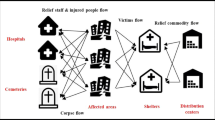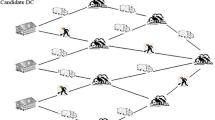Abstract
Choosing the locations and the capacities of emergency warehouses for the storage of relief materials is critical to the quality of services provided in the wake of a large-scale emergency such as an earthquake. This paper proposes a stochastic programming model to determine disaster sites’ locations as well as their scales by considering damaged scenarios of the facility and by introducing seismic resilience to describe the ability of disaster sites to resist earthquakes. The objective of the model is to minimize fixed costs of building emergency warehouses, expected total transportation costs under uncertain demands of disaster sites and penalty costs for lack of relief materials. A local branching (LB) based solution method and a particle swarm optimization (PSO) based solution method are proposed for the problem. Extensive numerical experiments are conducted to assess the efficiency of the heuristic according to the real data of Yunnan province in China.





Similar content being viewed by others
References
Boonmee, C., Arimura, M., Asada, T.: Facility location optimization model for emergency humanitarian logistics. Int. J. Disaster Risk Reduct. 24, 485–498 (2017)
Altay, N., Green, W.G.: OR/MS research in disaster operations management. Eur. J. Oper. Res. 175(1), 475–493 (2006)
Jia, H., Ordóñez, F., Dessouky, M.: A modeling framework for facility location of medical services for large-scale emergencies. IIE Trans. 39(1), 41–55 (2007)
Balcik, B., Beamon, B.M.: Facility location in humanitarian relief. Int. J. Logist. Res. Appl. 11(2), 101–121 (2008)
Yushimito, W.F., Jaller, M., Ukkusuri, S.: A voronoi-based heuristic algorithm for locating distribution centers in disasters. Netw. Spat. Econ. 12(1), 21–39 (2010)
Haghani, A., Oh, S.C.: Formulation and solution of a multi-commodity, multi-modal network flow model for disaster relief operations. Transp. Res. Part A Policy Pract. 30, 231–250 (1996)
Barbarosoǧlu, G., Arda, Y.: A two-stage stochastic programming framework for transportation planning in disaster response. J. Oper. Res. Soc. 55(1), 43–53 (2004)
Tzeng, G.H., Cheng, H.J., Huang, T.D.: Multi-objective optimal planning for designing relief delivery systems. Transp. Res. Part E Logist. Transp. Rev. 43(6), 673–686 (2007)
Cui, T., Ouyang, Y., Shen, Z.J.M.: Reliable facility location design under the risk of disruptions. Oper. Res. 58(4-part-1), 998–1011 (2010)
Rath, S., Gutjahr, W.J.: A math-heuristic for the warehouse location–routing problem in disaster relief. Comput. Oper. Res. 42, 25–39 (2014)
Abounacer, R., Rekik, M., Renaud, J.: An exact solution approach for multi-objective location–transportation problem for disaster response. Comput. Oper. Res. 41, 83–93 (2014)
Zhen, L., Wang, K., Liu, H.C.: Disaster relief facility network design in metropolises. IEEE Trans. Syst. Man Cybern. Syst. 45, 751–761 (2015)
Caunhye, A.M., Zhang, Y., Li, M., Nie, X.: A location-routing model for prepositioning and distributing emergency supplies. Transp. Res. Part E Logist. Transp. Rev. 90, 161–176 (2016)
Zhen, L.: Tactical berth allocation under uncertainty. Eur. J. Oper. Res. 247(3), 928–944 (2015)
Salman, F.S., Yücel, E.: Emergency facility location under random network damage: insights from the Istanbul case. Comput. Oper. Res. 62, 266–281 (2015)
Verma, A., Gaukler, G.M.: Pre-positioning disaster response facilities at safe locations: an evaluation of deterministic and stochastic modeling approaches. Comput. Oper. Res. 62, 197–209 (2015)
Yu, G., Haskell, W.B., Liu, Y.: Resilient facility location against the risk of disruptions. Transp. Res. Part B Methodol. 104, 82–105 (2017)
Qu, X., Wang, S., Zhang, J.: On the fundamental diagram for freeway traffic: a novel calibration approach for single-regime models. Transp. Res. Part B Methodol. 73, 91–102 (2015)
Moreno, A., Alem, D., Ferreira, D.: Heuristic approaches for the multiperiod location-transportation problem with reuse of vehicles in emergency logistics. Comput. Oper. Res. 69, 79–96 (2016)
Wang, S., Meng, Q.: Liner shipping network design with deadlines. Comput. Oper. Res. 41, 140–149 (2014)
Wang, S., Meng, Q.: Robust bunker management for liner shipping networks. Eur. J. Oper. Res. 243(3), 789–797 (2015)
Zhang, Y., Snyder, L.V., Qi, M., Miao, L.: A heterogeneous reliable location model with risk pooling under supply disruptions. Transp. Res. Part B Methodol. 83, 151–178 (2016)
Fischetti, M., Lodi, A.: Local branching. Math. Program. 98(1–3), 23–47 (2003)
Eberhart, R., Kennedy, J.: A new optimizer using particle swarm theory. In: Sixth International Symposium on Micro Machine and Human Science, MHS, pp. 39–43 (1995)
Yapicioglu, H., Smith, A.E., Dozier, G.: Solving the semi-desirable facility location problem using bi-objective particle swarm. Eur. J. Oper. Res. 177(2), 733–749 (2007)
Bruneau, M., Chang, S.E., Eguchi, R.T., Lee, G.C., O’Rourke, T.D., Reinhorn, A.M., Shinozuka, M., Tierney, K., Wallace, W.A., von Winterfeldt, D.: A framework to quantitatively assess and enhance the seismic resilience of communities. Earthq. Spectra 19(4), 733–752 (2003)
Takagi, T., Sugeno, M.: Fuzzy identification of systems and its applications to modeling and control. IEEE Trans. Syst. Man Cybern. Syst. 15, 116–132 (1985)
Author information
Authors and Affiliations
Corresponding author
Rights and permissions
About this article
Cite this article
Wang, BC., Li, M., Hu, Y. et al. Optimizing Locations and Scales of Emergency Warehouses Based on Damage Scenarios. J. Oper. Res. Soc. China 8, 437–456 (2020). https://doi.org/10.1007/s40305-018-0215-5
Received:
Revised:
Accepted:
Published:
Issue Date:
DOI: https://doi.org/10.1007/s40305-018-0215-5




